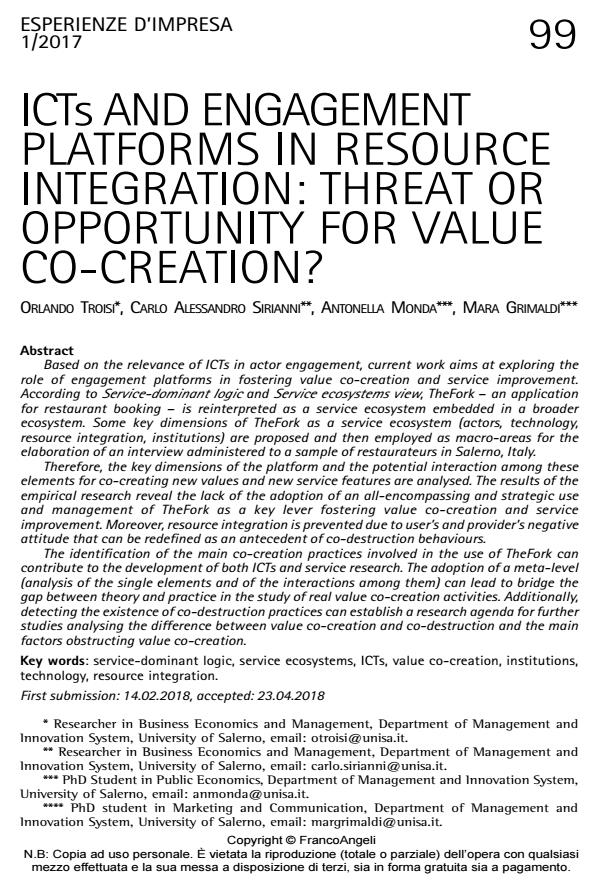ICTS and engagement platforms in resource integration: threat or opportunity for value co-creation?
Journal title ESPERIENZE D'IMPRESA
Author/s Orlando Troisi, Carlo Alessandro Sirianni, Antonella Monda, Mara Grimaldi
Publishing Year 2018 Issue 2017/1
Language English Pages 25 P. 99-123 File size 308 KB
DOI 10.3280/EI2017-001005
DOI is like a bar code for intellectual property: to have more infomation
click here
Below, you can see the article first page
If you want to buy this article in PDF format, you can do it, following the instructions to buy download credits

FrancoAngeli is member of Publishers International Linking Association, Inc (PILA), a not-for-profit association which run the CrossRef service enabling links to and from online scholarly content.
Based on the relevance of ICTs in actor engagement, current work aims at exploring the role of engagement platforms in fostering value co-creation and service improvement. According to Service-dominant logic and Service ecosystems view, TheFork - an application for restaurant booking - is reinterpreted as a service ecosystem embedded in a broader ecosystem. Some key dimensions of TheFork as a service ecosystem (actors, technology, resource integration, institutions) are proposed and then employed as macro-areas for the elaboration of an interview administered to a sample of restaurateurs in Salerno, Italy. Therefore, the key dimensions of the platform and the potential interaction among these elements for co-creating new values and new service features are analysed. The results of the empirical research reveal the lack of the adoption of an all-encompassing and strategic use and management of TheFork as a key lever fostering value co-creation and service improvement. Moreover, resource integration is prevented due to user’s and provider’s negative attitude that can be redefined as an antecedent of co-destruction behaviours. The identification of the main co-creation practices involved in the use of TheFork can contribute to the development of both ICTs and service research. The adoption of a meta-level (analysis of the single elements and of the interactions among them) can lead to bridge the gap between theory and practice in the study of real value co-creation activities. Additionally, detecting the existence of co-destruction practices can establish a research agenda for further studies analysing the difference between value co-creation and co-destruction and the main factors obstructing value co-creation.
Keywords: Service-dominant logic, service ecosystems, ICTs, value co-creation, institutions, technology, resource integration.
- Smart City as a Service System: A Framework to Improve Smart Service Management Francesco Polese, Antonio Botti, Antonella Monda, Mara Grimaldi, in Journal of Service Science and Management /2019 pp.1
DOI: 10.4236/jssm.2019.121001 - Managing Smart Cities Mara Grimaldi, pp.265 (ISBN:978-3-030-93584-9)
Orlando Troisi, Carlo Alessandro Sirianni, Antonella Monda, Mara Grimaldi, ICTS and engagement platforms in resource integration: threat or opportunity for value co-creation? in "ESPERIENZE D'IMPRESA" 1/2017, pp 99-123, DOI: 10.3280/EI2017-001005